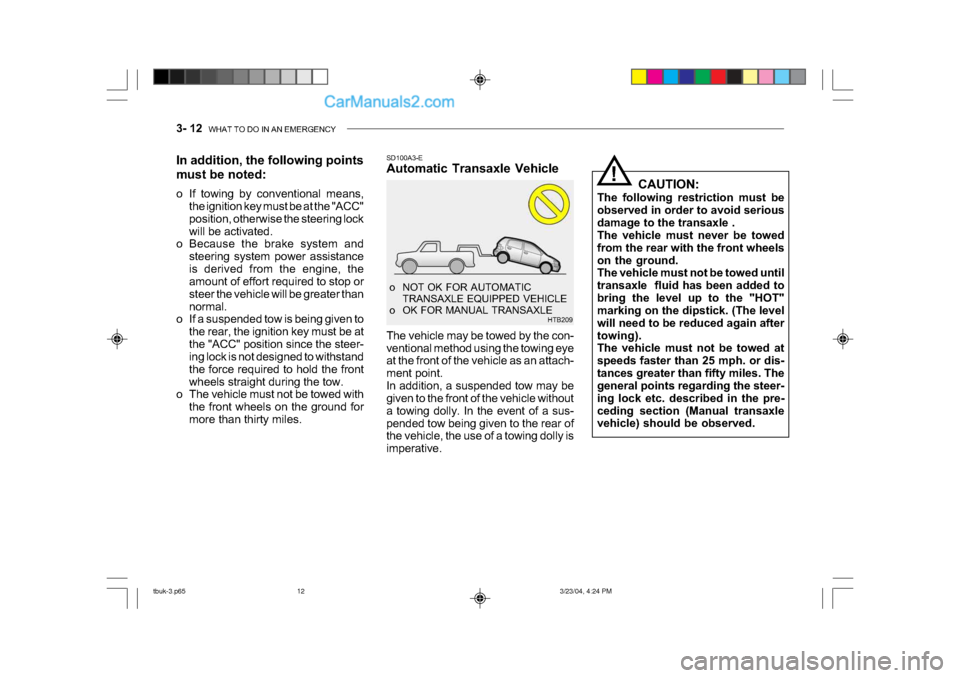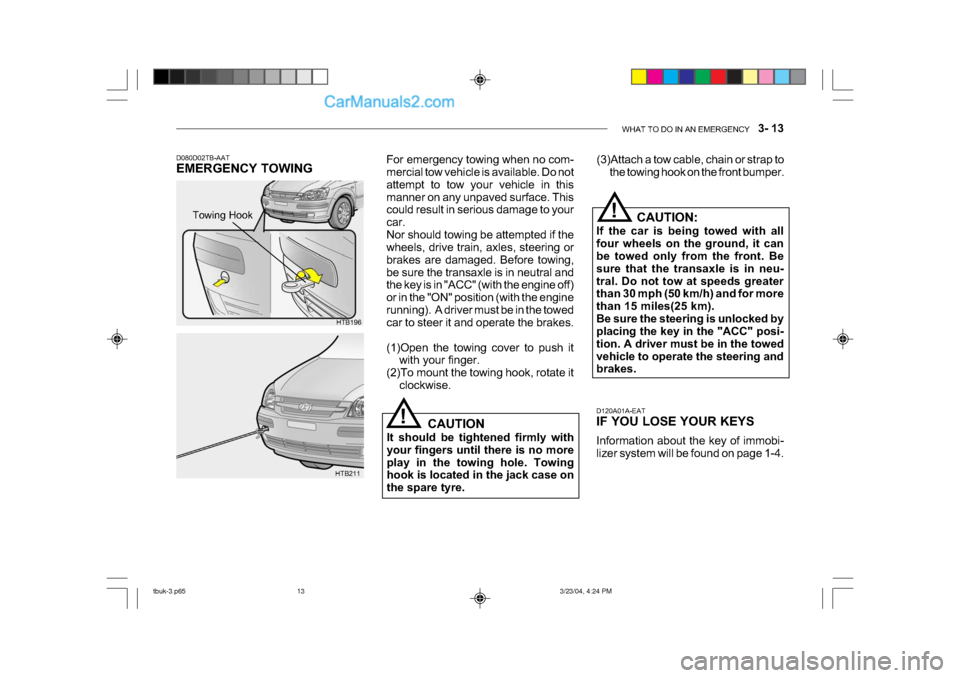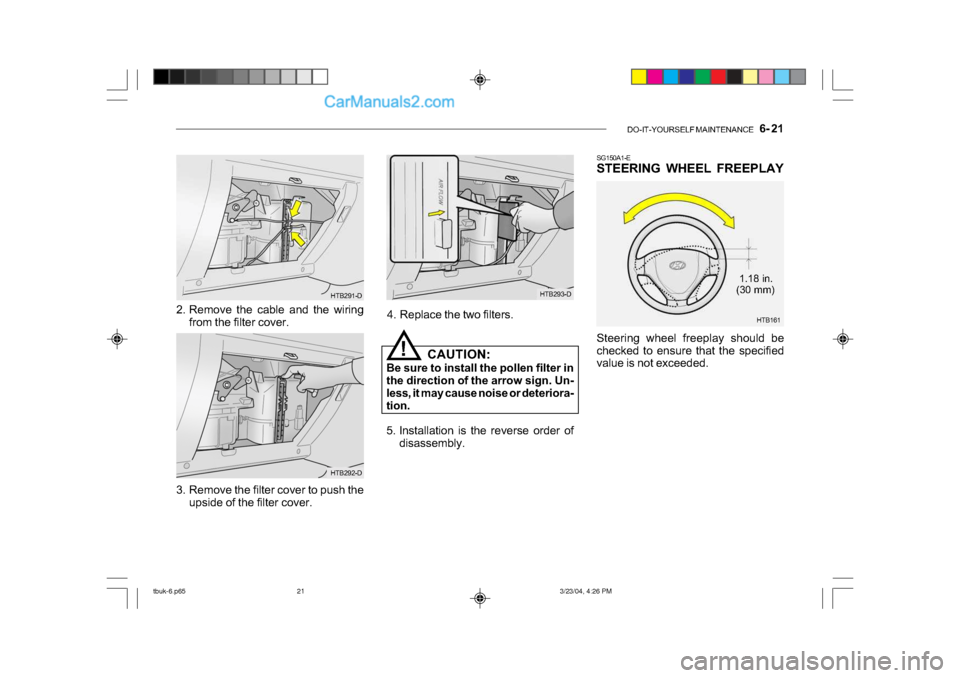2004 Hyundai Getz steering wheel
[x] Cancel search: steering wheelPage 360 of 445

DRIVING YOUR HYUNDAI 2- 17
!
o The formation of snow or ice built up
inside the wheel arches may inter- fere with the road wheels or steeringmechanism. In such instances, un-usual noises or an increase in steer- ing effort may result. Therefore, ensure that the wheel arches arechecked periodically and any accu-mulated snow or ice removed.
o It is advisable to carry emergency equipment including, torch, shovel, tow rope, blankets etc., if a journey is to be undertaken into areas ofsevere road conditions.
Nose weight Total trailer weight
C190E01L C195F02TB-EAT TOWING ATTACHMENTS It is strongly recommended that only an Hyundai Approved towing attach-ment is used to ensure that the loadsplaced upon the body structure arecorrectly distributed. The use of a non approved attachment will result in the invalidation of the vehicle warranty.Hyundai towing attachments are de-signed and constructed to ensuremaximum towing performance andease of fitment. A range of accesso- ries including electrical kits are avail- able through the Hyundai dealer net-work. It is of the utmost importance that those areas of the vehicle which are subjected to greater stress during tow- ing are maintained in accordance withthe recommendations given at the endof this book. In addition, the daily oper-ating checks relating to engine oil,transmission oil and tyres must be performed at each refuelling to ensure maximum reliability and safety.
C190E02TB-EAT TRAILER AND CARAVAN TOW- ING
WARNING:
It is not recommended that the ve- hicle be used for towing until thefirst 1,000 miles of Running In hasbeen completed. All Hyundai MA- TRIX models are suited to towing trailers and caravans up to the lim-its indicated on page 2-19. Thismodels fitted with automatictransaxle have a transaxle oil coolerand further transaxle cooling should not be required.
tbuk-2.p65 3/23/04, 4:55 PM
17
Page 374 of 445

WHAT TO DO IN AN EMERGENCY 3- 11
o OK FOR AUTOMATIC OR MANUAL
TRANSAXLE EQUIPPED VEHICLE
WITH NO DAMAGE HTB208
HTB151B080A02TB-EAT
VEHICLE TOWING OR
RECOVERY
CAUTION:
An incorrect tow or recovery could
result in serious damage to the ve-
hicle. If any damage to the suspen-
sion, steering or transaxle is appar-
ent or suspected, a towing ambu-
lance must be used. o OK FOR AUTOMATIC OR MANUAL
TRANSAXLE EQUIPPED VEHICLE
HTB207
!
SD070K1-E
AFTER CHANGING WHEELS
The pressure of the spare tyre should
be checked at the first available oppor-
tunity. If any doubt exists as to the tyre
pressure, the vehicle should be driven
slowly to the nearest service station
and the tyre pressure checked and
adjusted as required.
If the valve cap is lost from any of the
valves, a replacement should be ob-
tained and fitted at the first available
opportunity. The valve cap prevents
the ingress of dirt which may cause the
valve to stick and therefore leak and is
part of the valve sealing function. Ensure that the spare wheel, jack and
wheel nut wrench as well tools are
correctly located in the boot of the
vehicle to prevent damage and noise.
The vehicle may be towed by the con-
ventional method using the towing eye
at the front of the vehicle as an attach-
ment point. In addition, a suspended
tow with or without a towing dolly may
be used with either the front or the rear
wheels being suspended, provided the
above caution is observed.
tbuk-3.p65 3/23/04, 4:24 PM
11
Page 375 of 445

3- 12 WHAT TO DO IN AN EMERGENCY
!
CAUTION:
The following restriction must be
observed in order to avoid serious
damage to the transaxle .
The vehicle must never be towed
from the rear with the front wheels
on the ground.
The vehicle must not be towed until
transaxle fluid has been added to
bring the level up to the "HOT"
marking on the dipstick. (The level
will need to be reduced again after
towing).
The vehicle must not be towed at
speeds faster than 25 mph. or dis-
tances greater than fifty miles. The
general points regarding the steer-
ing lock etc. described in the pre-
ceding section (Manual transaxle
vehicle) should be observed.
SD100A3-E
Automatic Transaxle Vehicle
The vehicle may be towed by the con-
ventional method using the towing eye
at the front of the vehicle as an attach-
ment point.
In addition, a suspended tow may be
given to the front of the vehicle without
a towing dolly. In the event of a sus-
pended tow being given to the rear of
the vehicle, the use of a towing dolly is
imperative.
o NOT OK FOR AUTOMATIC
TRANSAXLE EQUIPPED VEHICLE
o OK FOR MANUAL TRANSAXLE HTB209
In addition, the following points
must be noted:
o If towing by conventional means,
the ignition key must be at the "ACC"
position, otherwise the steering lock
will be activated.
o Because the brake system and
steering system power assistance
is derived from the engine, the
amount of effort required to stop or
steer the vehicle will be greater than
normal.
o If a suspended tow is being given to
the rear, the ignition key must be at
the "ACC" position since the steer-
ing lock is not designed to withstand
the force required to hold the front
wheels straight during the tow.
o The vehicle must not be towed with
the front wheels on the ground for
more than thirty miles.
tbuk-3.p65 3/23/04, 4:24 PM
12
Page 376 of 445

WHAT TO DO IN AN EMERGENCY 3- 13
D120A01A-EAT
IF YOU LOSE YOUR KEYS
Information about the key of immobi-
lizer system will be found on page 1-4.CAUTION:
If the car is being towed with all
four wheels on the ground, it can
be towed only from the front. Be
sure that the transaxle is in neu-
tral. Do not tow at speeds greater
than 30 mph (50 km/h) and for more
than 15 miles(25 km).
Be sure the steering is unlocked by
placing the key in the "ACC" posi-
tion. A driver must be in the towed
vehicle to operate the steering and
brakes.
!
(3)Attach a tow cable, chain or strap to
the towing hook on the front bumper.
D080D02TB-AAT
EMERGENCY TOWING For emergency towing when no com-
mercial tow vehicle is available. Do not
attempt to tow your vehicle in this
manner on any unpaved surface. This
could result in serious damage to your
car.
Nor should towing be attempted if the
wheels, drive train, axles, steering or
brakes are damaged. Before towing,
be sure the transaxle is in neutral and
the key is in "ACC" (with the engine off)
or in the "ON" position (with the engine
running). A driver must be in the towed
car to steer it and operate the brakes.
(1)Open the towing cover to push it
with your finger.
(2)To mount the towing hook, rotate it clockwise.
HTB196
HTB211 CAUTION
It should be tightened firmly with
your fingers until there is no more
play in the towing hole. Towing
hook is located in the jack case on
the spare tyre.
!
Towing Hook
tbuk-3.p65
3/23/04, 4:24 PM
13
Page 386 of 445

VEHICLE MAINTENANCE REQUIREMENTS 5- 5
F030C02TB-EAT R : Replace I : Inspect and, after inspection, clean, adjust, repair or replace if necessary
GENERAL MAINTENANCE COOLING SYSTEMCOOLANTCOOLANT SPECIFIC GRAVITYMANUAL TRANSAXLE OILAUTOMATIC TRANSAXLE FLUIDBRAKE PIPES, HOSES, AND CONNECTIONSBRAKE FLUIDCLUTCH FLUIDREAR BRAKE LININGS AND CYLINDERSBRAKE PADSSUSPENSION AND STEERING SYSTEMFRONT SUSPENSION BALL JOINTSPOLLEN FILTER (FOR EVAPORATOR AND BLOWER UNIT)REAR WHEEL BEARINGSTYRE CONDITION AND PRESSURE (incl. Spare)LUBRICATE LOCKS AND HINGESCHECK ALL ELECTRICAL SYSTEMSROAD TESTCHECK ALL SYSTEMS WITH HI-SCAN
60 72
5060
4048
I I I
R
I
RR II I I
R III I II
I I I IIIII I II
R II I III
I I I II
RR I I II
R II I III
30 36
2024
I I I IIIII I II
R II I III
I I I II
RR I I II
R II I III
10 12
I I I IIIII I II
R II I III
MILES X 1000MONTHS
NO. DESCRIPTION
1 23456789
10111213141516171819
See NOTE (1)
Note :(1) FOR THE FIRST TIME, REPLACE THE COOLANT 60,000 MILES OR 60 MONTHS. AFTER THAT, REPLACE IT EVERY 30,000 MILES OR 24 MONTHS.
tbuk-5.p65 7/3/2008, 4:10 PM
5
Page 390 of 445

VEHICLE MAINTENANCE REQUIREMENTS 5- 9
F070E03A-AAT
o Automatic transaxle fluid
The fluid level should be in the "HOT" range of the dipstick, after engine and transaxle are at normal operating tem- perature. Check the AutomaticTransaxle Fluid level with the engine running and the transaxle in neutral, with the parking brake properly ap-plied. Use DIAMOND ATF SP-III or SK ATF SP-III when adding or chang- ing fluid. 6ZF070F1-A
o Brake hoses and lines
Visually check for proper installation, chafing, cracks, deterioration and any leakage. Replace any deteriorated ordamaged parts immediately. 6ZF070G2-A
o Brake fluid
Check brake fluid level in the brake fluid reservoir. The level should be between "MIN" and "MAX" marks on the side of the reservoir. Use onlyhydraulic brake fluid conforming to DOT 3 or DOT 4. 6ZF070H1-A
o Rear brake drums and linings/ parking brake
Check the rear brake drums and lin-
ings for scoring, burning, leaking fluid, broken parts, and excessive wear. Inspect the parking brake system in- cluding the parking brake lever andcables. For detailed service proce- dures, refer to the Shop Manual.
6ZF070J1-A
o Brake pads, calipers and
rotors
Check the pads for excessive wear,
discs for run out and wear, and cali-pers for fluid leakage.
6ZF070K1-A
o Exhaust pipe and muffler
Visually inspect the exhaust pipes,
muffler and hangers for cracks, dete- rioration, or damage. Start the engine and listen carefully for any exhaust gas leakage. Tighten connections orreplace parts as necessary. 6ZF070L1-A o Suspension mounting bolts Check the suspension connections for looseness or damage. Retighten to the specified torque. 6ZF070M1-A o Steering gear box, linkage &
boots/lower arm ball joint
With the vehicle stopped and engine off, check for excessive freeplay inthe steering wheel.Check the linkage for bends or dam-age. Check the dust boots and balljoints for deterioration, cracks, or dam- age. Replace any damaged parts. 6ZF070N1-A
o Power steering pump, belt and hoses
Check the power steering pump and hoses for leakage and damage. Re-place any damaged or leaking parts immediately. Inspect the power steer- ing belt for evidence of cuts, cracks,excessive wear, oiliness and proper tension. Replace or adjust it if neces- sary.
tbuk-5.p65 7/3/2008, 4:10 PM
9
Page 412 of 445

DO-IT-YOURSELF MAINTENANCE 6- 21
SG150A1-E
STEERING WHEEL FREEPLAY
Steering wheel freeplay should be
checked to ensure that the specified
value is not exceeded.
HTB293-D
4. Replace the two filters.
CAUTION:
Be sure to install the pollen filter in
the direction of the arrow sign. Un-
less, it may cause noise or deteriora-
tion.
5. Installation is the reverse order of disassembly.
!
3. Remove the filter cover to push the upside of the filter cover.
HTB291-D
2. Remove the cable and the wiring from the filter cover.
HTB292-D HTB161
1.18 in.
(30 mm)
tbuk-6.p65
3/23/04, 4:26 PM
21
Page 435 of 445

CONSUMER INFORMATION 8- 5
!
SI060B1-E
TYRE REPLACEMENT
Tyres must be replaced when the wear
indicators appear as a solid bar across
the tyre tread. At this point, the remain-
ing tread depth will be approximately
0.06 in.(1.6 mm). In addition to this, the
tyre must be replaced if any portion of
the tread has become bald or if there are
any lumps, bulges or deep cuts in the
sidewalls or tread.
Replacement tyres must be of the rec-
ommended size and rating and should
be of the same manufacture and tread
pattern on each axle.
SI060D2-E
WHEEL REPLACEMENT
Wear indicator
1.6 mm (0.06 in.)
HGK248
NOTE:
o Do not use the temporary spare
tyre for tyre rotation.
o Aluminium wheels which are not
supplied as Original Equipment
should not be mixed on the same
vehicle with the original steel
wheels. However, it is acceptable
that the steel spare wheel be used
in conjunction with Original Equip-
ment aluminium wheels since the
offset of both wheels is compat-
ible. Radial and cross ply tyres
should not be mixed on the same
vehicle.
SI060A1-E
TYRE BALANCING
Incorrect tyre balance will cause steer-
ing vibration and uneven tyre wear. The
vehicle tyres are balanced during pro-
duction but may need further balancing
throughout the life of the tyres.
It is recommended that the tyres be
balanced on the car for best results and
that the tyres are balanced whenever
they have been removed from the wheel
for repair. The original wheels may only be re-
placed with Hyundai Approved wheels.
WARNING:
Driving on worn or defective tyres is
dangerous. Worn tyres may cause
loss of steering control and a seri-
ous deterioration of braking effi-
ciency. Defective tyres may cause
vibration and loss of control through
blow outs.
Tyres of different size, construction or
tread pattern should not be intermixed
on the same axle. Radial and cross ply
tyres should not be used on the same
vehicle.
The use of tyres and wheels of non
approved sizes can be dangerous.
tbuk-8.p65 3/23/04, 4:27 PM
5